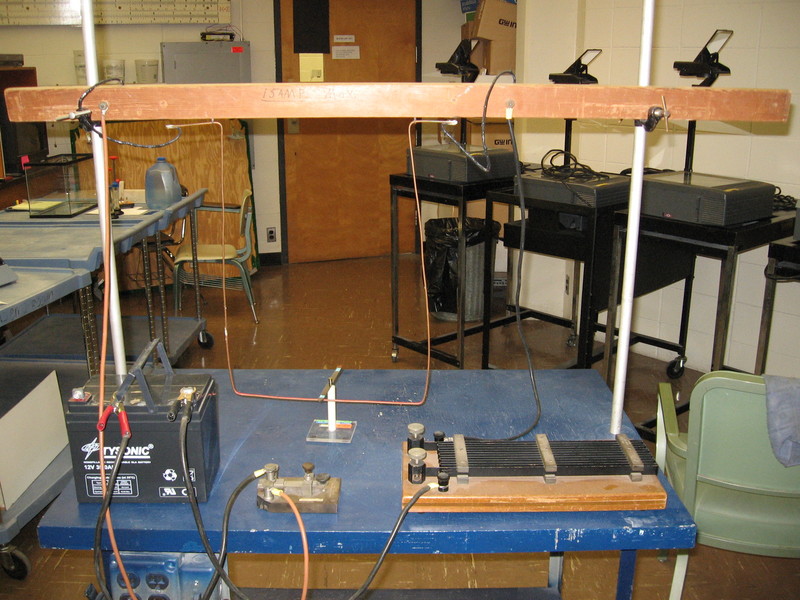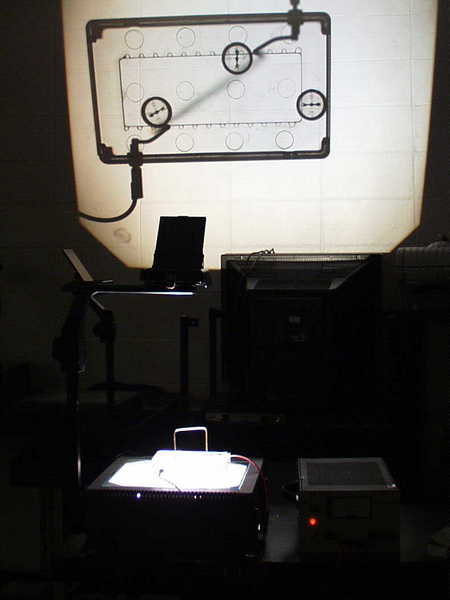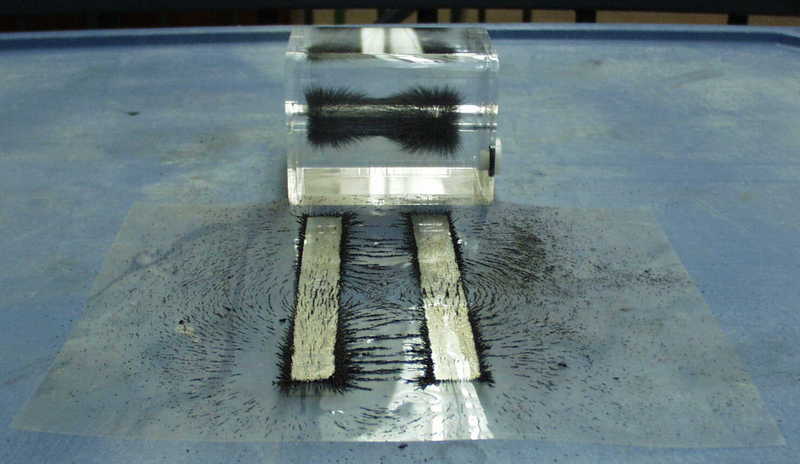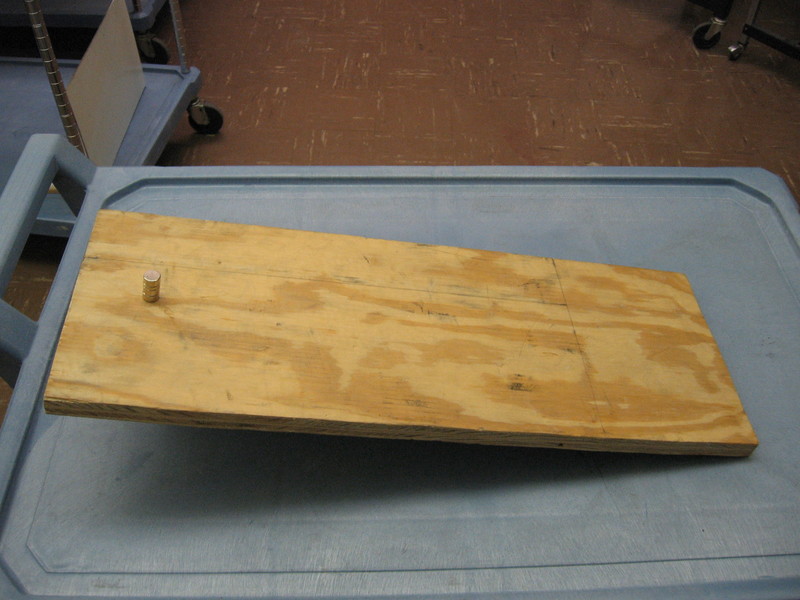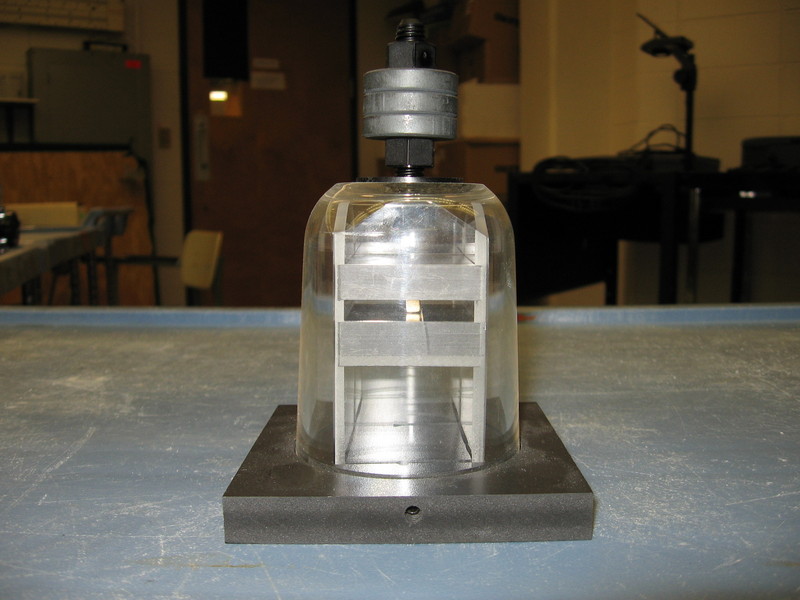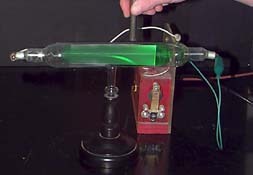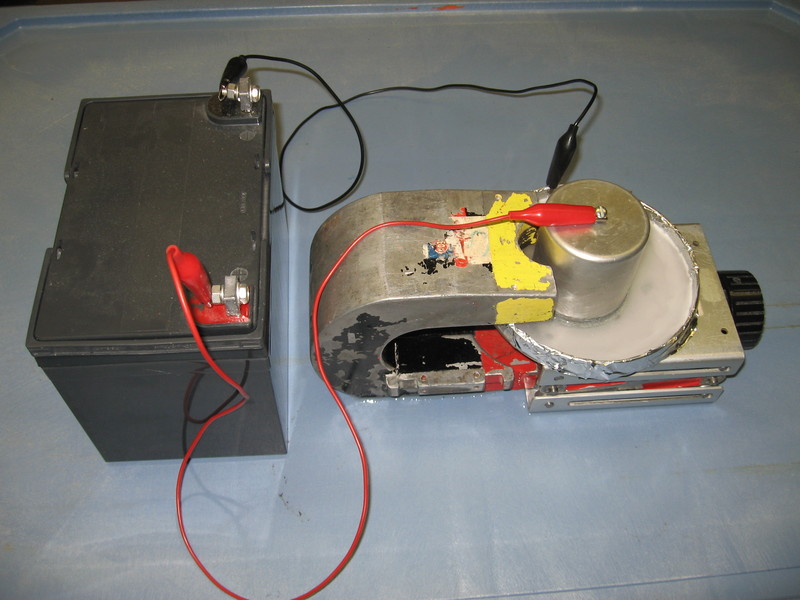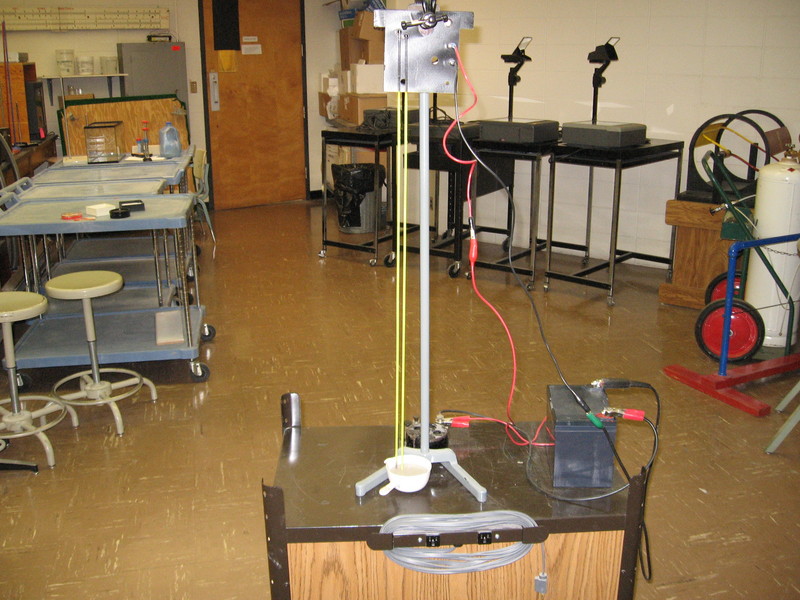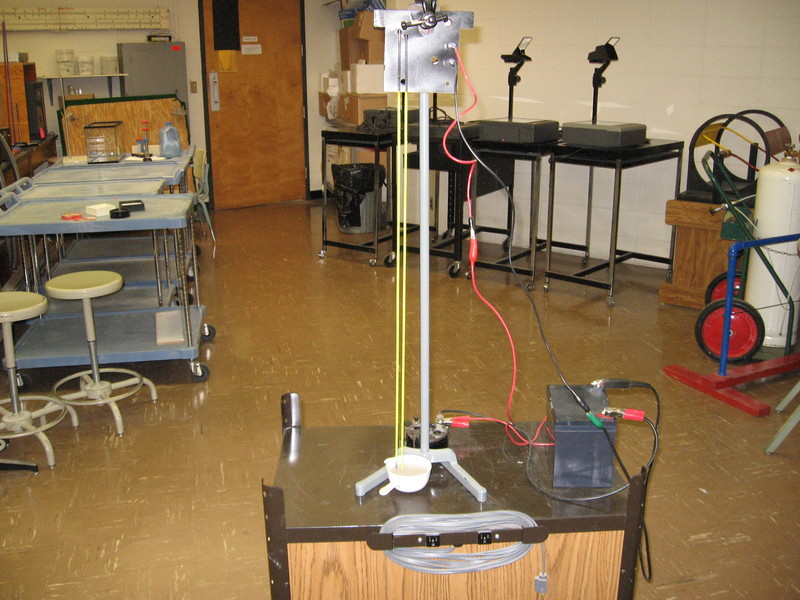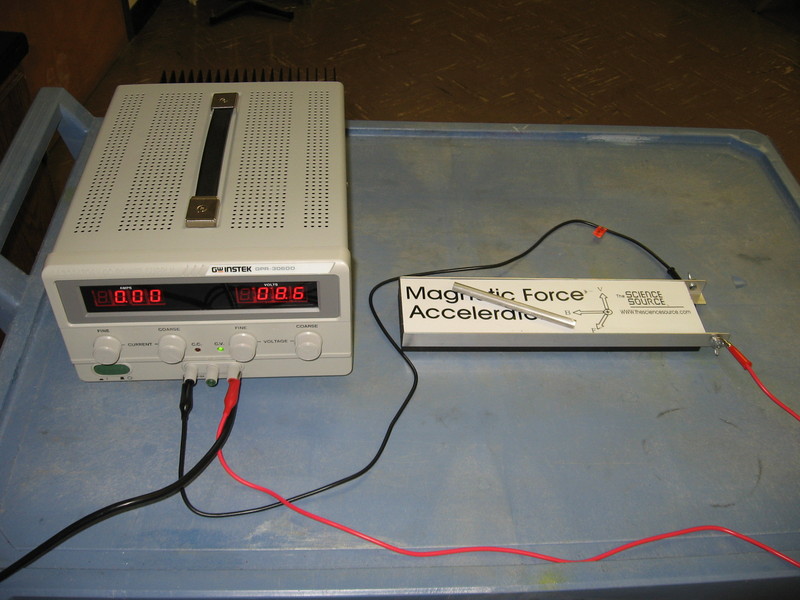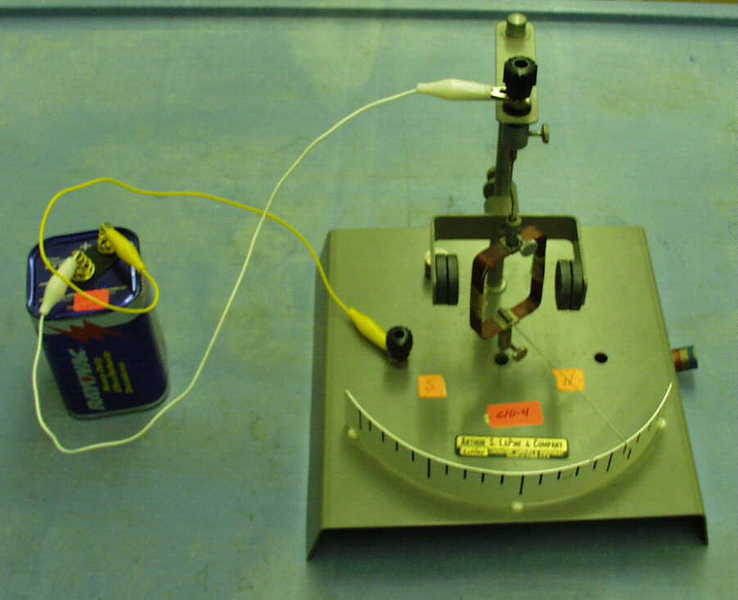MAGNETIC FIELDS & FORCES
5H10.20 Oersted Effect #1 (New Device)5H10.21 OERSTED EFFECT #2
5H10.30 MAGNET AND IRON FILINGS
5H20.05 MAGNET IN EARTH'S FIELD
5H20.10 MAGNET ON PIVOT
5H20.22 MAGNETIC LEVITATION
5H30.10 CATHODE RAY TUBES (CROOKES)
5H30.56 MAGNETIC FIELD MOVES WATER
5H40.10 PARALLEL WIRES- REPULSION (New Device)
5H40.11 PARALLEL WIRES-ATTRACTION (New Device)
5H40.30 JUMPING WIRE
5H40.32 MAGNETIC FORCE ACCELERATOR (RAIL GUN)
5H50.10 TORQUE ON LOOP
|
5H10.20 Oersted's Effect #1 Due to changes to limit current in jumping wire demo, the version show in the photograph below is no longer available. It has been replaced by a device called Sturgeon's Galvanometer. To see what it looks like use Google to search for pictures of this device. Setup Requirements (Revised): Assembled as needed. A power supply that can provide at least 12 Amps is needed. Turn device so needle lined up with metal structure. Set on zero volts before turning on power supply. As you increase the current the needle will move so it is close to being perpendicular to metal structure carrying current. It will not be exactly perpendicular due to Earth's field.. Equations: None Safety Issues: Danger of large current. Insulation on thin wires may start smoking if current left on too long. . |
|
5H10.21 Oersted's Effect #2 Explore the field around a wire with compass needles by using this device on overhead projector. Compass on right side points north-south. Other compasses affected by current in wire. A solenoid is also available for use on overhead projector. A large solenoid is also available.
Setup Requirements: Assembled as needed. Adjust power supply voltage until compass needles respond to magnetic field. Equations: None Safety Issues: Large current in bare wire. Keep small compasses away from strong magnets. |
|
5H10.30 Magnet and Iron Filings Show magnetic field pattern around bar magnet using iron filings. Show using an overhead projector.
Setup Requirements: Minimal. Several magnet types available. Equations: None Safety Issues: Heavy, strong or brittle magnets |
|
5H20.05 Magnet in Earth's Field The effect of the Earth's magnetic field on a magnet can be demonstrated by rolling a small but strong disc shaped magnet down a wooden incline. Instead of rolling straight down the magnet will curve to left or right depending on orientation.
Setup Requirements: Minimal Equations: None Safety Issues: Strong brittle magnets |
|
5H20.10 Magnet on a Pivot One magnet is placed on a pivot, the other is used to attract or repel the first.
Setup Requirements: Minimal Equations: None Safety Issues: None |
|
5H20.22 Magnetic Levitation Objects suspended using static electric or magnetic fields are usually considered examples of unstable equilibrium. We have a device that uses two plates of diamagnetic material to stabilize a small magnet levitated using a magnetic field. Setup Requirements: You will need to hook a web camera to a computer to show this in a large classroom. May need to adjust spacing of magnets. Equations: None Safety Issues: None |
|
5H30.10 Cathode Ray Tube Deflect the beam in a Crookes tube with a magnet.
Setup Requirements: Assembled as needed. If it does not produce green beam, switch wires attached to tube. Bar magnets may not be strong enough. Use red transformer. Equations: F = qV x B Safety Issues: X-ray radiation. Keep students away. If broken tube cannot be replaced. |
|
5H30.56 Magnetic Field Moves Water You can move water using a magnet as well as charged rod. The magnet exerts a force on the current between the foil and center electrode. Navies of the world are trying to use this as a silent means of propulsion.
Setup Requirements: At least 1 day advance notice needed to assemble and test. Aluminum foil is placed around the edge of a container of salt water. It is placed between the poles of a magnet. A car battery is connected to the electrode and the aluminum foil. Equations: F=qvxB and F= idlxB Safety Issues: Electrolysis will occur. If it runs too long hydrogen may build up and explode. |
|
5H40.10 Parallel Wires-Repulsion A new version has replaced the one shown in the picture below.Long vertical parallel rods repel. Current goes down one wire and up the other. Setup Requirements: Minimal Equations: Force proportional to I x L x B. Safety Issues: High current. Use pushbutton switch to limit time current flows. Draws over 50 amps. |
|
5H40.11 Parallel Wires-Attraction A new version has replaced that in picture below. Long vertical parallel rods attract. Current goes in same direction in both wires. Setup Requirements: Minimal Equations: Force proportional to I x L x B. Safety Issues: High current. Use pushbutton switch to limit time current flows. Draws ~ 50 amps. |
|
5H40.30 Jumping Wire A wire is placed between poles of a horseshoe magnet and connected to a battery. The wire jumps out of the magnet.
Equations: Force proportional to I x L x B. Safety Issues: If you leave switch closed more than a few seconds the insulation can start smoking at full current. A resistor has been installed to reduce current. |
|
5H40.32 Magnetic Force Accelerator (Rail Gun) Place rod close to rail and drop so it lands on both rails. It will roll off the device due to the magnetic force exerted when a current flows. Direction of motion depends on how power supply hooked up. Use right/left hand rule to determine direction of force. The direction of the field is up.The field is supplied by permanent magnets under the white area.
Setup: Minimal. Rub rails and rod with clean cloth before using. Adjust voltage to 6v without rod on rails. Increase if rod will not roll. Limit of 12V.
Equations: F= qvxB and F=idlxB. Safety Issues. Do not touch rails or rod (when on rails) when power supply on. Sparks may be produced depending on voltage. Sparks can dirty or damage rails and rod. Keep voltage to minimum needed to get rod moving. |
|
5H50.10 Torque on Current Carrying Loop Galvanometer model used to show torque on a loop carrying current in a magnetic field.
Setup Requirements: Assembled as needed. Equations: Torque = current x area x field x sine(A) Safety Issues: None |

